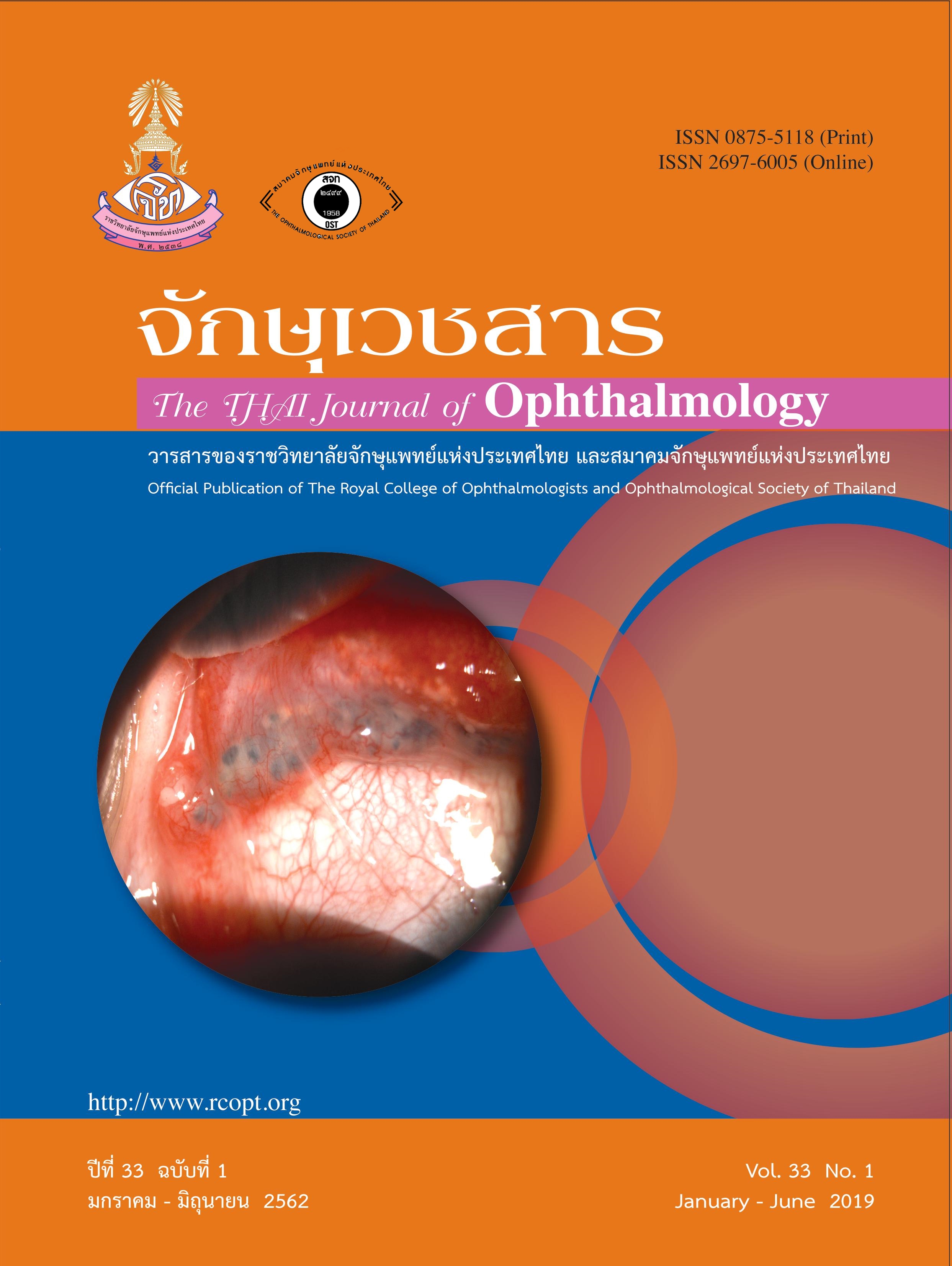Outcomes of Therapeutic Penetrating Keratoplasty in a Tertiary Care Hospital in Thailand
Keywords:
Therapeutic penetrating keratoplasty, corneal ulcer, corneal perforation, anatomical success, therapeutic success, functional successAbstract
Objective To study the outcomes of Therapeutic Penetrating Keratoplasty (TPK) in a tertiary hospital in
Thailand
Method A retrospective study was performed by reviewing hospital records of patients underwent TPK
in Mettapracharak (Wat Raiking) Hospital during January 2016 and December 2018. Demographic data,
preoperative, operative and post-operative ophthalmic data were collected. Post-operative follow up were
performed in month 1, 3 and 6. The study was performed to analyze the outcomes of TPK and determine
the factors that affected the therapeutic outcome.
Results During the study period, there were 277 keratoplasties in the hospital. TPK accounted for 81 eyes
(29.2%). Ninety percent of the patients were referred from other hospitals. Sixty five percent of the patients
have fungal corneal infections. The anatomical success, therapeutic success and functional success were
achieved in 79.0%, 88.8% and 74.0% respectively. Analysis of risk factors associated with treatment failure
shows that corneal perforation was associated with anatomical failure (OR = 23.26, p < 0.0001), functional
failure (OR = 5.95, p = 0.002) but no effect on therapeutic success (OR = 1.0, p = 0.49.).
Conclusion TPK is the last treatment measure to try to preserve the patient’s’ eye in patients with severe
corneal infections or corneal perforation. In this series, 79% of globe could be salvaged, 88% of eyes could
get rid of infection and 74% of eyes could maintain vision. The earlier TPK decision should result in better
treatment results.
References
Flaxman SR, Bourne RRA, Resnikoff S, et al. Global causes of blindness and distance vision impairment 1990-2020: a systematic review and meta-analysis. Lancet Glob Health 2017;5(12):e1221-e34.
Whitcher JP, Srinivasan M, Upadhyay MP. Corneal blindness: a global perspective. Bull World Health Organ 2001;79(3):214-21.
Tan JC, Holland SP, Dubord PJ, et al. Evolving indications for and trends in keratoplasty in British Columbia, Canada, from 2002 to 2011: a 10-year review. Cornea 2014;33(3):252-6.
Rahman I, Carley F, Hillarby C, et al. Penetrating keratoplasty: indications, outcomes, and complications. Eye (Lond) 2009;23(6):1288-94.
Chen WL, Wu CY, Hu FR, Wang IJ. Therapeutic penetrating keratoplasty for microbial keratitis in Taiwan from 1987 to 2001. Am J Ophthalmol 2004;137(4):736-43.
Nurozler AB, Salvarli S, Budak K, et al. Results of therapeutic penetrating keratoplasty. Jpn J Ophthalmol 2004;48(4):368-71.
L P, S E, P S. Indications for corneal transplantation in Thailand between 1996 and 2008. Asian Biomedicine;5(6).
Chaidaroon W, Ausayakhun S, Ngamtiphakorn S, Prasitsilp J. Clinical indications for penetrating keratoplasty in Maharaj Nakorn Chiang Mai Hospital, 1996-1999. J Med Assoc Thai 2003;86(3):206-11.
Khor WB, Prajna VN, Garg P, et al. The Asia Cornea Society Infectious Keratitis Study: A Prospective Multicenter Study of Infectious Keratitis in Asia. Am J Ophthalmol 2018;195:161-70.
Zhang Q, Zhao M, Xu M, et al. Outcomes of therapeutic keratoplasty for severe infectious keratitis in Chongqing, a 16-year experience. Infect Drug Resist 2019;12:2487-93.
Lalitha P, Prajna NV, Kabra A, et al. Risk factors for treatment outcome in fungal keratitis. Ophthalmology 2006;113(4):526-30.
Prajna NV, Srinivasan M, Lalitha P, et al. Differences in clinical outcomes in keratitis due to fungus and bacteria. JAMA Ophthalmol 2013;131(8):1088-9.
Tu EY, McCartney DL, Beatty RF, et al. Successful treatment of resistant ocular fusariosis with posaconazole (SCH-56592). Am J Ophthalmol 2007;143(2):222-7.
Sharma N, Jain M, Sehra SV, et al. Outcomes of therapeutic penetrating keratoplasty from a tertiary eye care centre in northern India. Cornea 2014;33(2):114-8.
Thylefors B. Epidemiological patterns of ocular trauma. Aust N Z J Ophthalmol 1992;20(2):95-8.
Nirmalan PK, Katz J, Tielsch JM, et al. Ocular trauma in a rural south Indian population: the Aravind Comprehensive Eye Survey. Ophthalmology 2004;111(9):1778-81.
Downloads
Published
Issue
Section
License
The Thai Journal of Ophthalmology (TJO) is a peer-reviewed, scientific journal published biannually for the Royal College of Ophthalmologists of Thailand. The objectives of the journal is to provide up to date scientific knowledge in the field of ophthalmology, provide ophthalmologists with continuing education, promote cooperation, and sharing of opinion among readers.
The copyright of the published article belongs to the Thai Journal of Ophthalmology. However the content, ideas and the opinions in the article are from the author(s). The editorial board does not have to agree with the authors’ ideas and opinions.
The authors or readers may contact the editorial board via email at admin@rcopt.org.


